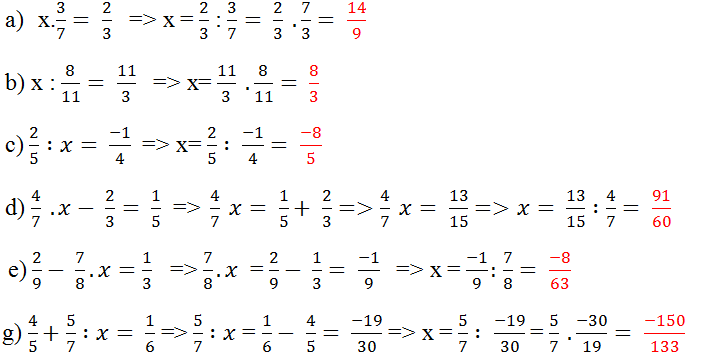Hãy nhập câu hỏi của bạn vào đây, nếu là tài khoản VIP, bạn sẽ được ưu tiên trả lời.

a) Ta có: \(\dfrac{4}{x}+\dfrac{y}{3}=\dfrac{5}{6}\)
\(\Rightarrow\dfrac{4}{x}=\dfrac{5}{6}-\dfrac{y}{3}\)
\(\Rightarrow\dfrac{4}{x}=\dfrac{5-2y}{6}\)
\(\Rightarrow\left(5-2y\right)x=24\)
Vì \(x,y\in Z\Rightarrow\left[{}\begin{matrix}5-2y\in Z\\x\in Z\end{matrix}\right.\)
\(\Rightarrow5-2y\inƯ\left(24\right);x\inƯ\left(24\right)\)
Tự lập bảng xét các giá trị của \(x,y\) nhé.
b) Lại có: \(\dfrac{5}{x}-\dfrac{y}{3}=\dfrac{1}{6}\)
\(\Rightarrow\dfrac{5}{x}=\dfrac{1}{6}+\dfrac{y}{3}\)
\(\Rightarrow\dfrac{5}{x}=\dfrac{1+2y}{6}\)
\(\Rightarrow\left(1+2y\right)x=30\)
Lí luận rồi lập bảng như câu \(a\)).
c) \(\dfrac{x}{6}-\dfrac{2}{y}=\dfrac{1}{30}\)
\(\Rightarrow\dfrac{2}{y}=\dfrac{x}{6}-\dfrac{1}{30}\)
\(\Rightarrow\dfrac{2}{y}=\dfrac{5x-1}{30}\)
\(\Rightarrow\left(5x-1\right)y=60\)
\(......Tương\) \(tự\) \(như\) \(câu\) \(a\))\(b\)).

a) \(\dfrac{x}{3}-\dfrac{4}{y}=\dfrac{1}{5}\)
\(\dfrac{4}{y}\) = \(\dfrac{x}{3}-\dfrac{1}{5}\)
\(\dfrac{4}{y}\) = \(\dfrac{5x-3}{15}\)
=> 4.15 = y.(5x-3)
60 = y.(5x-3)
Ta có bảng
| 5x-3 | 1 | 60 | 2 | 30 | 3 | 20 | 4 | 15 | 5 | 12 | 6 | 10 |
| y | 60 | 1 | 30 | 2 | 20 | 3 | 15 | 4 | 12 | 5 | 10 | 6 |
| x | 4/5 | 63/5 | 1 | 33/5 | 6/5 | 23/5 | 7/5 | 18/5 | 8/5 | 3 | 9/5 | 13/5 |
| L | L | TM | L | L | L | L | L | L | TM | L | L |
Vậy y=30 và x=1 ; y=5 và x=3

a) \(\dfrac{-5}{6}.\dfrac{120}{25}< x< \dfrac{-7}{15}.\dfrac{9}{14}\)
\(\Rightarrow-4< x< \dfrac{-3}{10}\)
\(\Rightarrow\dfrac{-40}{10}< x< \dfrac{-3}{10}\)
\(\Rightarrow x\in\left\{\dfrac{-39}{10};\dfrac{-38}{10};\dfrac{-37}{10};...;\dfrac{-5}{10};\dfrac{-4}{10}\right\}\)
b) \(\left(\dfrac{-5}{3}\right)^2< x< \dfrac{-24}{35}.\dfrac{-5}{6}\)
\(\Rightarrow\dfrac{25}{9}< x< \dfrac{4}{7}\)
\(\Rightarrow\dfrac{175}{63}< x< \dfrac{36}{63}\)
\(\Rightarrow x=\varnothing\)
c) \(\dfrac{1}{18}< \dfrac{x}{12}< \dfrac{y}{9}< \dfrac{1}{4}\)
\(\Leftrightarrow\dfrac{2}{36}< \dfrac{3x}{36}< \dfrac{4y}{36}< \dfrac{9}{36}\)
\(\Rightarrow x\in\left\{1;2\right\}\)
+) Với \(x=1\)
\(\Rightarrow y\in\left\{1;2\right\}\)
+) Với \(x=2\)
\(\Rightarrow y=2\)
Vậy \(x=1\) thì \(y\in\left\{1;2\right\}\); \(x=2\) thì \(y=8\).

bài 3:
a, đặt \(\dfrac{x}{12}=\dfrac{y}{9}=\dfrac{z}{5}=k\)
=>x=12k,y=9k,z=5k
ta có: ayz=20=> 12k.9k.5k=20
=> (12.9.5)k^3=20
=>540.k^3=20
=>k^3=20/540=1/27
=>k=1/3
=>x=12.1/3=4
y=9.1/3=3
z=5.1/3=5/3
vậy x=4,y=3,z=5/3
b,ta có: \(\dfrac{x}{5}=\dfrac{y}{7}=\dfrac{z}{3}=\dfrac{x^2}{25}=\dfrac{y^2}{49}=\dfrac{z^2}{9}\)
A/D tính chất dãy tỉ số bằng nhau ta có:
\(\dfrac{x}{5}=\dfrac{y}{7}=\dfrac{z}{3}=\dfrac{x^2}{25}=\dfrac{y^2}{49}=\dfrac{z^2}{9}=\dfrac{x^2+y^2-z^2}{25+49-9}=\dfrac{585}{65}=9\)
=>x=5.9=45
y=7.9=63
z=3*9=27
vậy x=45,y=63,z=27

Bài 2: a) \(\dfrac{x-3}{x+5}=\dfrac{5}{7}\)
\(\Leftrightarrow\left(x-3\right).7=\left(x+5\right).5\)
\(\Leftrightarrow7x-21=5x+25\)
\(\Leftrightarrow7x-5x=21+25\)
\(\Leftrightarrow2x=46\)
\(\Rightarrow x=46:2=23\)
b) \(\dfrac{7}{x-1}=\dfrac{x+1}{9}\)
\(\Leftrightarrow\left(x+1\right)\left(x-1\right)=63\)
\(\Leftrightarrow x^2-1=63\)
\(\Leftrightarrow x^2=64\)
\(\Rightarrow x^2=\left(\pm8\right)^2\)
\(\Rightarrow x=8\) hoặc \(x=-8\)
2)a) \(\dfrac{x-3}{x+5}=\dfrac{5}{7}\)
\(\Leftrightarrow7\left(x-3\right)=5\left(x+5\right)\)
\(7x-21=5x+25\)
\(7x-5x+25=21\)
\(2x+25=21\)
\(2x=-4\Rightarrow x=-2\)
b) \(\dfrac{7}{x-1}=\dfrac{x+1}{9}\)
\(7.9=\left(x+1\right)\left(x-1\right)\)
\(63=x\left(x-1\right)+1\left(x-1\right)\)
\(63=x^2-x+x-1\)
\(x^2=63+1=64\)
\(x=\left\{\pm8\right\}\)
c) \(\dfrac{x+4}{20}=\dfrac{2}{x+4}\)
\(\Leftrightarrow\left(x+4\right)\left(x+4\right)=2.20=40\)
\(x\left(x+4\right)+4\left(x+4\right)=40\)
\(x^2+4x+4x+16=40\)
\(x^2+8x=40-16=24\)
\(x\left(x+8\right)=24\)
\(x\in\left\{\varnothing\right\}\)
d) \(\dfrac{x-1}{x+2}=\dfrac{x-2}{x+3}\)
\(\Leftrightarrow\left(x+2\right)\left(x-2\right)=\left(x-1\right)\left(x+3\right)\)
\(x\left(x-2\right)+2\left(x-2\right)=x\left(x+3\right)-1\left(x+3\right)\)
\(x^2-2x+2x-4=x^2+3x-x-3\)
\(\)\(x^2-4=x^2+2x-3\)
\(\Leftrightarrow x^2-x^2-2x+3=4\)
\(-2x+3=4\)
\(-2x=1\)
\(x=-\dfrac{1}{2}\)

a) \(x\)=1 \(y\)= 12
b)\(x\)=4 \(y\)= 14
hoặc \(x\)= 6 \(y \)=21
...

a) \(\dfrac{x}{5}=\dfrac{6}{-10}\)
\(\Rightarrow\) (-10).x=5.6
\(\Leftrightarrow\) (-10).x=30
\(\Leftrightarrow x=30:\left(-10\right)\)
\(\Leftrightarrow\) x=(-3)
Vậy......................
b) \(\dfrac{x}{3}=\dfrac{4}{y}\)
\(\Rightarrow xy=3.4=12\)
Ta có: xy=12=1.12=12.1=2.6=6.2=3.4=4.3=(-1).(-12)=......( bạn tự ghi nốt)
\(\Rightarrow\)(x;y)=(1;12) (12;1) (2;6) (6;2) (3;4) (4;3) (-1;-12) (-12;-1) (-2;-6) (-6;-2) (-3;-4) (-4;-3)
Vậy.....................................
a: x/5=6/-10
=>x/5=-3/5
=>x=-3
b: =>xy=12
=>\(\left(x,y\right)\in\left\{\left(1;12\right);\left(12;1\right);\left(-1;-12\right);\left(-12;-1\right);\left(2;6\right);\left(6;2\right);\left(-2;-6\right);\left(-6;-2\right);\left(3;4\right);\left(4;3\right);\left(-3;-4\right);\left(-4;-3\right)\right\}\)
c: =>x/2=y/7=k
=>x=2k; y=7k
=>\(\left(x,y\right)\in\left\{\left(2k;7k\right);k\in Z\right\}\)
d: 2/x=x/8
=>x^2=16
=>x=4 hoặc x=-4